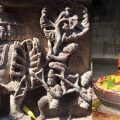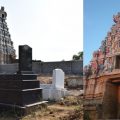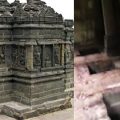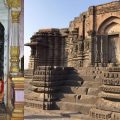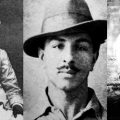How Villagers of Lonar Defeated and Killed Afghan Invaders to Save Vishnu Temple
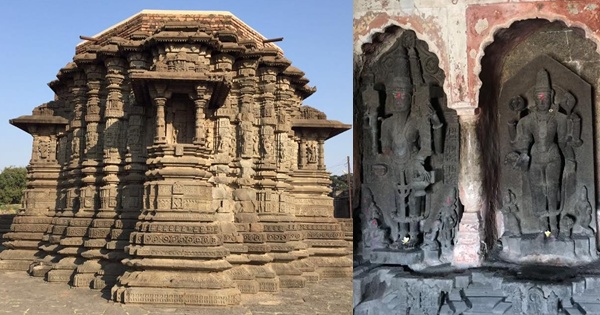
Around 50,000 years ago (you can even double it to avoid any calculation mistake), a large fireball (we call it meteorite) fell in today’s Lonar village near the historical city of Aurangabad in the state of Maharashtra. This incredible natural event was one of a kind extraterrestrial phenomenon in the world!! The meteorite actually broke the security net of Mother Earth, landed awkwardly (I am sure with a lot of fuss, impact, sound & gas!!) creating this amazing Lonar crater and over time Lonar lake.
This lake which is green, circular, neutral (inner) and alkaline (outer) at the same time is somewhat eerie and devoid of humans (at least when we visited)!! It looks dead but has a lot of mystery buried inside. Micro organisms which are never found anywhere in the world is swarming in profusion in the lake along with unexplained chemical occurrences. Peculiar rocks, glass and minerals are spread all over the crater and the lake shore (I collected few). The compass doesn’t work here and several NASA teams have made repeated visits in this crater. The locals claim that nobody knows what is buried in the centre of the lake!!
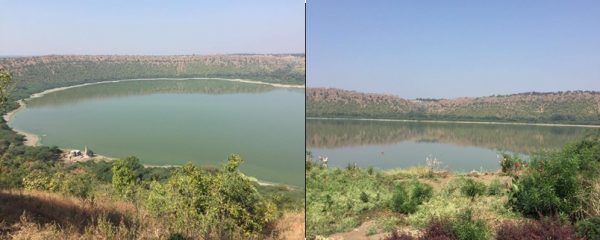
The lake has many temples and ruins all around creating a mythical atmosphere but at the same time is very thought provoking, especially if one has a natural acumen towards historical events. Seriously, Lonar Lake has immense potential and the government must make it attractive for tourists.
You need to climb down the crater, climb up and may be twice if you want to experience everything. And suffer from a short term memory loss in the process. Gasping for breath and thinking of what happens if you have an emergency condition!!! Never mind this exercise will make you even stronger as you just cannot miss the Datya Sudan temple somewhere in the vicinity of the Lonar village!
While maneuvering through a constricted road inside the Lonar village you will “all of a sudden” come across this stunning architectural splendor – Daitya Sudan temple. As you walk towards this somewhat “curious” mélange structure (there are portions of patchwork with diverse architecture towards the front facade and the roof) amidst numerous broken pillars and artifacts, you may pause for a while to look at a huge mud wall on the right side of the temple, as if it has been scraped off or burrowed!!
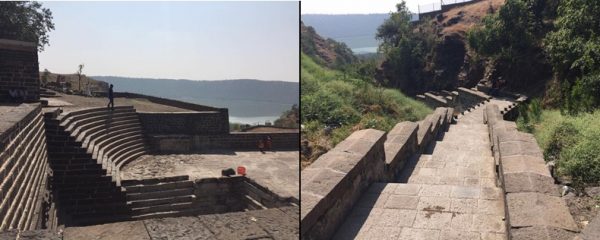
The temple was believed to be built by Vikramaditya II of Chalukya dynasty in the 8th century. The architecture confirms the Chalukyan influence and Hoysala as well.
The temple has a brilliant but untold story. I am sure you don’t know!! I can bet!!
It was circa 12th century during the innumerable raids of Muhammad Ghori in India. Small gangs of Afghan prowlers ventured into famous Hindu Holy places primarily to conduct a recce or to gather information about the wealth for a later raid or even to ransack temples with the aim of quick gains (from temple funds). These Afghan gangs on horseback comprised of mercenaries who could wipe out a complete village without batting an eye. One such mercenary gang entered the Lonar pilgrim centre as they heard of many temples surrounding the sacred place, especially about a “Vishnu temple” in the vicinity of Lonar, as powerful and revered as Somnath, Mathura and Varanasi.
There was an alarm in the village. This small pilgrim community had gusty residents. They were simple people but they loved their beloved God more than anything. The villagers thus came together and they decided to combat!!! “No they won’t allow their deity to be touched….these mlecchas should not step in the temple courtyard”. A fierce battle ensued from a mere scuffle between the villagers and the mercenaries. So much was their love and devotion for their deity that without caring for their lives the villagers countered the looters and inadvertently killed all them!! The village lost many young lives too.
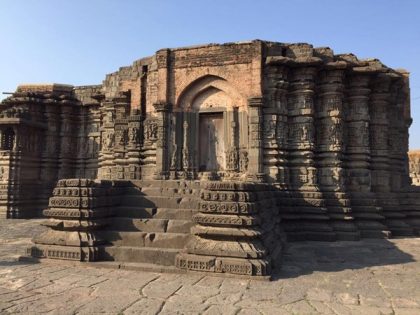
What happens next was one of its kind in the history of India! The villagers knew that the disappearance of the mercenary gang near Lonar will not go unavenged by Ghori. This barbaric invader will come back and repeat a “Ghaznavi style” Somnath like plunder or even worse. So they took a stoic decision – hide the complete temple by burying it under a mound of soil!!
They would change the face of the village! Their Lord can never be dishonored by these Afghan prowlers. The temple thus got hidden under a huge mound of earth and the deity secretly taken out and quietly shrouded at a secret place!!
The Afghans kept a suspicious eye always even after Ghori followed by Khilji and even the Tughlaqs and Mughals. They knew there was something missing as one Afghan in the mercenary gang was none other than Omar Basim. The temple continued to be buried for several centuries. Slowly, the invaders overlooked; even the villagers of Lonar village forgot about their Vishnu temple, as generations passed and elderly villagers died with this secret forever. The Vishnu Temple was lost in oblivion!!!
In circa 1800, a pious man by the name Sachidananda Swamy visited Lonar from his home town in coastal Maharashtra when he learnt that Lonar lake water had miraculous power to heal skin disease. He had a badly infected leg and was suffering for long. Swamy eventually got cured and stayed back in Lonar. He gradually built his own ashram and by a twist of fate, at the base of the ‘temple mound’!!!
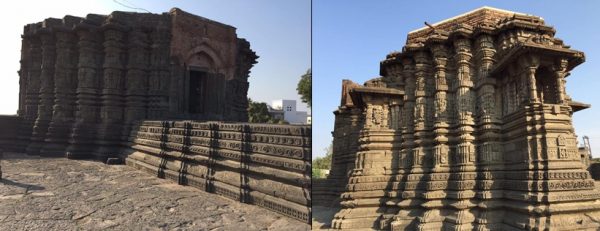
It seemed like a regular arrangement. Every morning one lone “eagle” sat atop the green hillock waiting for Sachidananda Swamy to come up for his early morning bhajans from his ashram below. As soon as Swamy climbed up the elevation and took his seat on that large slab of black stone at the centre of the mound and started his hymns, the “eagle” would quietly fly away!!
One day Sachdananda Swamy decided to construct a small prayer hall at the top of the mound. “This is a perfect spot for my morning and evening bhajans” he thought. He hired a few local construction workers for building his prayer hall. As the local team started digging the hillock for laying the foundation stone, the mound caved into some hard structure beneath. The workers continued to dig with greater vigor trying to break the solid rock below, which further caved in. The workers fell into a dark hall like structure. As they looked around with fire torches they found themselves inside an ancient temple!! Thus Swamy along with the local workers accidentally discovered the lost Vishnu temple of Lonar, as luck would have it!!
Swamy carefully climbed down the large opening on the collapsed roof of the newly uncovered temple along with the village heads. They landed in an open space which looked like a big hall followed by a small prayer room leading to the sanctum sanctorum. The inside of the hall had beautiful carvings which were now damaged and scattered all over. To their utter surprise, they found the Garbagriha or the innermost sanctum completely empty and had no deity in it!! Instead there was a small tablet on the raised platform with an inscription in Sanskrit stating that this place once had a very revered Vishnu deity. At one corner of the Sanctum sanctorum was a statue of Garuda (the Humanoid Eagle or Vahana/Mount of Lord Vishnu)!! Swamy recalled that “eagle that alighted every morning”
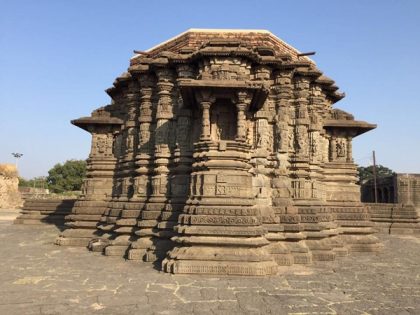
Slowly and meticulously, the workers did manage to dig out the entire temple but they were not professional excavators. The entire roof and the frontal facade of the temple collapsed in the process causing serious damage to the structure.
The Mughal era saw a systematic eradication of Hindu temple architecture and the rise of Islamic architecture. The skilled temple workers slowly faded away to give rise to a group of architect specialist in Islamic monuments and tombs. The ancient Hindu architecture was completely forbidden and thus Hindu architects were thoroughly wiped out methodically!!
Sachidananda Swamy’s search for a skilled Hindu architect ended in finding the new age “Indo-Islamic” architects who knew only one style of construction and thus the broken frontal facade as well as the roof was reconstructed with a stamp of Mughal architecture. The Vishnu temple now was a melange of Indo-Islamic frontal!! The stone temple inner walls were reconstructed with bricks giving it a rather disagreeable look!!
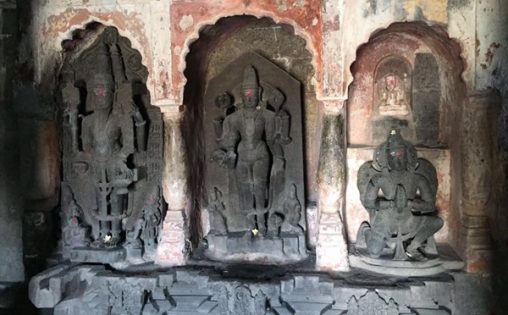
Swami furthermore successfully scraped out a tower at the entrance of the temple. There was a Garuda statue placed on the tower. He called it “Vishnu Stumbh”. On the left they unearthed a medium sized temple on a raised platform with several steps, a hall and some magnificent pillars, again one of its kind. It was a very rare temple of Hindu Holy Trinity – Brahma, Vishnu, Shiva, all three beautifully carved supreme divinity in this temple. The creator, The Preserver and The Destroyer rarely seen in one alter and under one temple roof! Swami stumbled into another mystery. “Oh Lord Vishnu,what’s going on!!” Swami was immersed into deep thought.
The nearby villagers flocked to see the new discovery. A magnificent temple came out from beneath the earth devoid of any deity while the other one had the Holy Trinity! Moreover, there were whispers about the statue of Lord Shiva in the Trinity temple. Some said it was alien, a diffused blue light radiated from the Shiva figurine in the dark. The villagers were amazed and confused at the same time!!
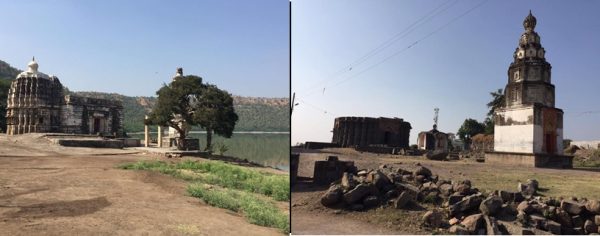
Swamy consulted the religious heads and all concluded equivocally that a Vishnu deity should be placed in the inner Sanctorum of the principal temple. No doubt this hallowed shrine was once revered and believed to be very sacred. Thus, a special black iron ore statue (with high metal content) of Lord Vishnu was brought from adjoining state of Madhya Pradesh (Nagpur?). The statue was of “Daitya Sudan”, the Upavatar of Lord Vishnu standing on the monster called Lonarasur or Lavanasur (As mentioned in Vishnupuran: Lord Vishnu killed Lonarasur or Lavanasur in his incarnation of young Sudan at Lonar). Although the idol lacks expertise in sculpture, it did have grace. The lack of expertise is credited to the Mughals who successfully eradicated Hindu artisans from the society.
The Daitya Sudan temple was purified, invoked through a special ritual of “Prana Prathista” and continuous recital of Vishnu mantras. Devotees thronged from all over the country. The temple bells resonated, divine smell of incense travelled across the village, along with Swamy’s bhajans. The village was charged up for revisiting the past glory amidst the downfall of the Peshwas and rise of British Raj.
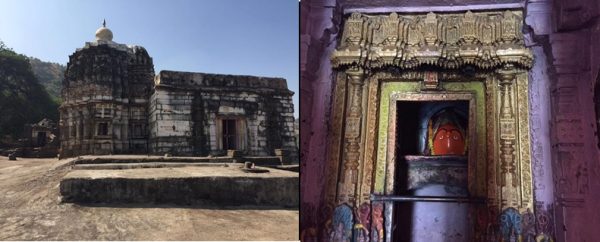
One thought however kept haunting Sachidananda Swamy every moment.”Why was the Sanctum Sanctorum empty? What happened to the original ancient Vishnu deity of this temple? Where was the deity hidden?” Until one day he unexpectedly discovered a copper plate at the base of the altar of the Trinity temple while cleaning it, which described the entire episode of how and why the temple was buried. The copper plate mentions that the deity was scheduled for a safe haven without any further disclosure!!
Meanwhile, Swamy grew older and spent his remaining days praising Lord Daitya Sudan who revealed extraordinary historical events through him to the world but had an unfulfilled desire – the mystery of the original Vishnu deity of the premier temple. The British East India Company took over from the Peshwas/Marathas opening a new chapter in Maharashtra’s history by the year 1818. Lonar lost its glory while entire of India got busy getting attuned under the British Raj until one day when British officer JE Alexander visited Lonar crater in 1823.
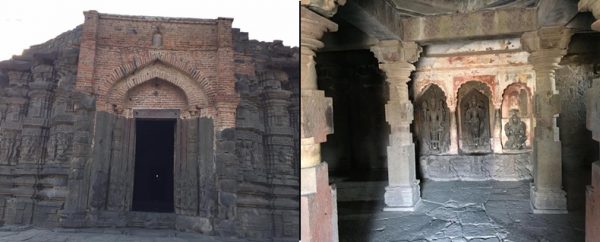
JE Alexander, more than a British officer, was actually an explorer and historian. He knew about the Prophetic Omar Basim, the missing Afghan (Arab Balkan) mercenary. He also knew about the group of Arab-Balkan tribe who were settled in disguise for centuries now in a nearby village (65 km from Lonar) named after Omar Basim, called Bashim or Washim!! What was their search??? Who was Omar Basim?? What did JE Alexander exactly know??
Part II (Conclusion): Mystery behind Excavation of a Gigantic Black Stone Vishnu Idol in 1888 at Mehkar
Visit the author’s personal travel blog Travel Truth & Myth. Explore heritage tourist places with Pii India Tour and Travels.

